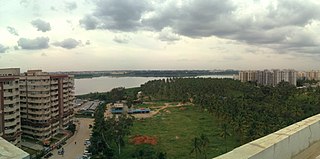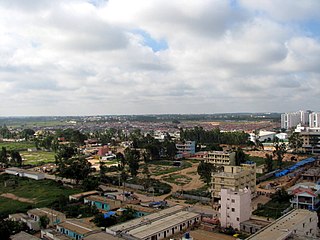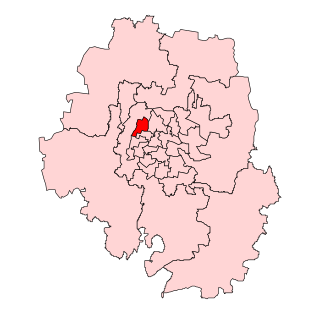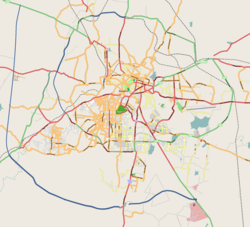
Electronic City is an information technology hub in Bangalore, India, located in Anekal taluk. Spread over 800 acres (3.2 km²) near Konappana Agrahara and Doddathogur it houses a large number of electronic/IT industrial parks.

Whitefield is a neighbourhood of Bangalore in the state of Karnataka, India. Established in 1882 as a settlement for the Eurasians and Anglo Indians of Bangalore, Whitefield remained a quaint little settlement at the eastern periphery of Bangalore city till the late 1990s when the local IT boom turned it into a major suburb. It is now a major part of Greater Bangalore. Whitefield is Bengaluru's first tech corridor to be connected by Namma Metro.

Basaveshwaranagara, also known as Basaveshwaranagar, Basaveshnagara or Basaveshnagar is a largely residential neighbourhood in the west of Bengaluru, Karnataka, India. It is located to the west of Rajajinagara and is sandwiched between the localities of Mahalakshmi Layout to the north and Vijayanagara to the south, spread across multiple sub-localities, three assembly constituencies and seven Bruhat Bengaluru Mahanagara Palike (BBMP) wards. The area of Basaveshwaranagara is often considered West of Chord Road as it lies to the west of Chord Road, an arterial road in the western part of Bengaluru.

Koramangala is a southeastern neighbourhood of the Indian city of Bengaluru. One of the largest in that metropolis, it is a residential locality with wide, tree-lined boulevards and a mix of commercial structures and bungalows. Planned as a suburb post-independence, its location between Bengaluru and Electronic City attracted migrants from across the country during Bengaluru's tech boom of the late 1990s. Consequently, it has gradually developed into a commercial centre and a prominent startup hub.

Indiranagar, is an affluent, medium-sized neighbourhood in east Bangalore, Karnataka, India. Indiranagar is one of the most expensive cosmopolitan neighbourhoods in Bangalore.

Namma Metro, also known as Bengaluru Metro, is a rapid transit system serving the city of Bengaluru, the capital city of the state of Karnataka, India. It is the second longest operational metro network in India with an operational length of 73.75 kilometers, just behind Delhi Metro. Upon its inauguration, it became the first underground metro system in South India. Namma Metro has a mix of underground, at grade, and elevated stations. Out of the 66 operational metro stations of Namma Metro as of October 2023, there are 57 elevated stations, eight underground stations and one at-grade station. The system runs on standard-gauge tracks.

The Bangalore Development Authority (BDA) of Bangalore, India, is a governmental organization and the principal planning authority for Bangalore. Its function, under the Karnataka Town and Country Planning Act of 1961, is as a regulatory body required "to prepare in the prescribed manner a Comprehensive Development Plan" for the Bangalore Metropolitan Region. It also oversees planning and development of infrastructure, provision of development-related sites and services, the housing needs of underprivileged citizens in Bangalore and is currently the city's largest land developer. No other authority or person may undertake development within the Bangalore Metropolitan Region without the permission of the BDA.

Yalahanka is a suburb and Taluk of Bangalore Urban district in the Indian state of Karnataka. One of the zones of BBMP. It is the oldest part of present Municipal Bengaluru (Bangalore) city and the northern end of the city. It is Nadaprabhu Kempegowda I, of the Yelahanka Prabhu clans, who laid the foundation of present-day Bengaluru through the creation of a "mud fort town" in 1537 CE

Devanahalli, also called "Devandahalli", "Dyaavandalli", Devanadoddi, and Devanapura, is a town and Town Municipal Council in Bengaluru Rural district in the state of Karnataka in India. The town is located 40 kilometres (25 mi) to the north-east of Bengaluru. Devanahalli is the site of Kempegowda International Airport. A multibillion-dollar Devanahalli Business Park with two IT Parks are coming up on nearly 400 acres (1.6 km2) adjoining the airport. An Aerospace Park, Science Park and a ₹10 billion (US$130 million) Financial City are also coming up. A new satellite ring road will connect the city with Doddaballapur. Devanahalli is situated near the upcoming ₹1,500 billion (US$19 billion), 12,000-acre (49 km2) BIAL IT Investment Region, to be the largest IT region in India.
Bangalore is the capital and the largest city of the Indian state of Karnataka. It is India's third largest city and fifth largest metropolitan area. Modern Bengaluru was founded in 1537 CE by Kempe Gowda, a vassal of the Vijayanagara Empire. Kempe Gowda built a mud fort in the vicinity of modern Bengaluru. By 1831, the city was incorporated into the British Raj with the establishment of the Bangalore Cantonment. The British returned dominion of the city to the King of Mysore, choosing however, to retain jurisdiction over the cantonment. Therefore, Bengaluru essentially became a twin city, with civic and infrastructural developments of the cantonment conforming to European styles of planning. For most of the period after Indian independence in 1947, Bengaluru was a B-1 status city, and was not considered to be one of India's "4 major metropolitan cities". The growth of Information Technology in the city, which is the largest contributor to India's software exports, has led to a decadal growth that is second to only that of India's capital New Delhi. The city's roads, however, were not designed to accommodate the vehicular traffic, growing at an average of 8% annually, that prevails in Bengaluru. This leads to heavy slow traffic and traffic jams in Bengaluru Foreign visitors are often shocked to see the state of infrastructure. Particularly during the monsoon season, commute becomes a challenge. The crippling infrastructure and lack of a robust mass transit network have led to the city having one of the worst average commute times in the world.

Malleshwaram is a northwest neighborhood and one of the zones of Bruhat Bengaluru Mahanagara Palike in Bengaluru, India. It was planned in 1889 after the great plague of 1898, developed as a suburb in 1892 and handed over to the city municipality in 1895. As per the 1878 Survey of India map, the area came under the village of Ranganatha Palya and was later named after the Kadu Malleshwara Temple. The neighbourhood houses many offices, one them being World Trade Center Bengaluru. It has two shopping malls, Mantri Square and Orion Mall. Education boards of the state KSEEB and PU boards are located here.
BTM Layout, an abbreviation of Byrasandra, Tavarekere and Madiwala Layout is a locality in Bengaluru, Karnataka, India located in the South and Southeast parts of the city between Hosur Road and Bannerghatta Road. It is one of the first layouts in Bangalore.
Located in South Bangalore, Karnataka, India, Kumaraswamy Layout is a sub locality in Banashankari.

The central business district of Bangalore is the area within a 6 km radius around Vidhan Soudha. This is the center of the city and core commercial area of Bangalore which was founded by Kempegowda of the Vijayanagara Empire. Most of the land is used by commercial establishments and the Indian Army with plans of skyscrapers under works. It has multiple high-rises including World Trade Center Bangalore and UB Tower. It also includes heritage properties like the Bangalore Fort and the Bangalore Pete.

Bellandur Lake is located in the suburb of Bellandur in the southeast of the city of Bengaluru. It is the largest lake in the city. It is a part of Bellandur drainage system that drains the southern and the south-eastern parts of the city. The lake is a receptor from three chains of lakes upstream, and has a catchment area of about 148 square kilometres. Water from this lake flows further east to the Varthur Lake, from where it flows down the plateau and eventually into the Pinakani river basin.

Green Line of Namma Metro was built along with the Purple Line during the first phase of construction of the metro rail system for the city of Bengaluru, Karnataka, India. The 30.5 km (19.0 mi) line connects Nagasandra in the northwest to Silk Institute in the south. The line connects the industrial centers of Peenya and Yeshwanthpur in the north with the central hub of Majestic and the southern residential areas of Bangalore. Green Line is mostly elevated, with 26 elevated and 3 underground stations. The Line passes through Majestic station which is an interchange station between Green and Purple Lines.

S. Suresh Kumar is an Indian Bharatiya Janata Party politician who was the Minister of state for Primary & Secondary Education and Sakala of Karnataka from 20 August 2019 to 26 July 2021. He was the Minister of state for Law & Parliamentary Affairs of Karnataka from 7 June 2008 to 13 May 2013.

Bellandur is a suburb in south-east Bangalore, Karnataka, India. It is bounded by HSR Layout to the west, Devarabisanahalli to the east, Sarjapur Road to the south, and the Bellandur Lake to the north. The Bellandur Lake is the largest lake in Bangalore, and separates Bellandur from the HAL Airport. The Outer Ring Road passes through Bellandur, making the area an important transit point between east and south Bangalore.

Mahalakshmi Layout Assembly Constituency is one of the 224 legislative assembly segments of the state of Karnataka. It is a part of Bengaluru Urban district and comes under the Bengaluru North parliamentary constituency.




















